 Part three of the Functionally Fit knee-focused miniseries looks at the lateral band walk/lunge, a pair of procedures that help counter IT band syndrome, informally known as runner's knee.
Part three of the Functionally Fit knee-focused miniseries looks at the lateral band walk/lunge, a pair of procedures that help counter IT band syndrome, informally known as runner's knee. See 'Related Resources' below for past Functionally Fits (including the knee series) and other exercises and training tips.
Execution
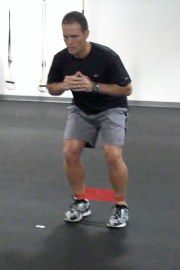
Place an ankle loop around both ankles (thighs for weaker clients).
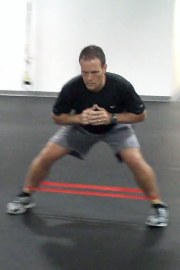 | 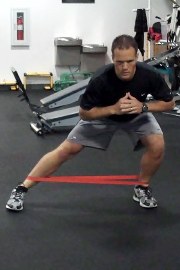 |
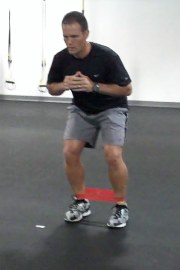 |  |
Perform two to three sets and repeat the exercise for 30 seconds or 10-15 repetitions each direction.
Note: Be sure to use a band or loop that offers ample resistance but does not impede form or create fatigue too quickly.
Application
This is one of my preferred exercise methods to strengthen the gluteus medius and treat runner's knee, also known as iliotibial (IT) band syndrome at the knee. While not everyone with IT band syndrome or anterior knee pain has a weak gluteus medius, most clients will tend to show imbalances and benefit from some selective strengthening of the hip abductors.
Stronger hip abductors will also reduce femoral adduction and internal rotation with jump landing, cutting and pivoting - all motions associated with non-contact ACL tears. Teaching your clients to stay low during this exercise will also improve overall glute muscle firing (more burn) and dynamic hip strength and control.
For advanced recreational clients and field/court athletes, I eventually progress to a lateral speed shuffle back and forth as well as forward and backward diagonal shuffles to work on deceleration and corresponding hip turns/control. Consider starting with two cones about 10 yards apart, and decrease the distance as form allows to increase the demand on the neuromuscular system and facilitate crisper planting and cutting.
Brian Schiff, PT, CSCS (http://www.brianschiff.com) is a licensed physical therapist, respected author and fitness professional. He became a Certified Strength and Conditioning Specialist (CSCS) in 1998. In 2000, he opened his own personal training and sport-specific conditioning facility, Fitness Edge, in Dublin, Ohio. Brian has presented at several professional conferences and seminars on injury prevention and sport-specific training.
Part three of the Functionally Fit knee-focused miniseries looks at the lateral band walk/lunge, a pair of procedures that help counter IT band syndrome, informally known as runner's knee.
See 'Related Resources' below for past Functionally Fits (including the knee series) and other exercises and training tips.
Execution
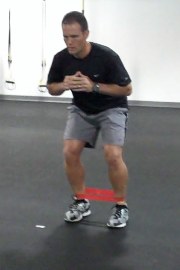
Place an ankle loop around both ankles (thighs for weaker clients).
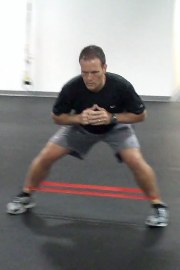 | 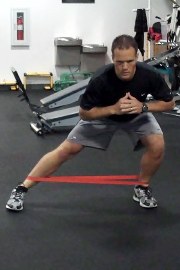 |
 | 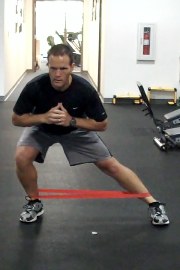 |
If doing the lateral band walk, simply bring the trail leg toward the stepping leg and repeat the cycle moving laterally for a set number of reps or time one way and then the other.
Perform two to three sets and repeat the exercise for 30 seconds or 10-15 repetitions each direction.
Note: Be sure to use a band or loop that offers ample resistance but does not impede form or create fatigue too quickly.
Application
This is one of my preferred exercise methods to strengthen the gluteus medius and treat runner's knee, also known as iliotibial (IT) band syndrome at the knee. While not everyone with IT band syndrome or anterior knee pain has a weak gluteus medius, most clients will tend to show imbalances and benefit from some selective strengthening of the hip abductors.
Stronger hip abductors will also reduce femoral adduction and internal rotation with jump landing, cutting and pivoting - all motions associated with non-contact ACL tears. Teaching your clients to stay low during this exercise will also improve overall glute muscle firing (more burn) and dynamic hip strength and control.
For advanced recreational clients and field/court athletes, I eventually progress to a lateral speed shuffle back and forth as well as forward and backward diagonal shuffles to work on deceleration and corresponding hip turns/control. Consider starting with two cones about 10 yards apart, and decrease the distance as form allows to increase the demand on the neuromuscular system and facilitate crisper planting and cutting.
Brian Schiff, PT, CSCS (http://www.brianschiff.com) is a licensed physical therapist, respected author and fitness professional. He became a Certified Strength and Conditioning Specialist (CSCS) in 1998. In 2000, he opened his own personal training and sport-specific conditioning facility, Fitness Edge, in Dublin, Ohio. Brian has presented at several professional conferences and seminars on injury prevention and sport-specific training.
















